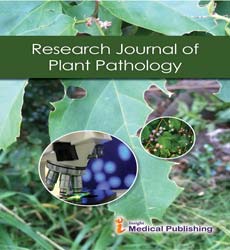Predominant Bacterial Wilt and Extending Potato Yields
Yin Jin*
Department of Plant Pathology, University of Nairobi, Nairobi, Kenya
- *Corresponding Author:
- Yin Jin
Department of Plant Pathology,
University of Nairobi, Nairobi,
Kenya,
E-mail: Jin_Y@gmail.com
Received date: November 10, 2023, Manuscript No. IPRJPP-23-18264; Editor assigned date: November 13, 2023, PreQC No. IPRJPP-23-18264 (PQ); Reviewed date: November 27, 2023, QC No. IPRJPP-23-18264; Revised date: December 04, 2023, Manuscript No. IPRJPP-23-18264 (R); Published date: December 11, 2023, DOI: 10.36648/iprjpp.6.4.180
Citation: Jin Y (2023) Predominant Bacterial Wilt and Extending Potato Yields. J Res Plant Pathol Vol.6 No.4: 180.
Description
A huge negative relationship between's bacterial shrink occurrences and yield at all destinations with the exception featured the significance of controlling bacterial shrivel for yield improvement. The discoveries propose that dirt revision through liming is a viable and manageable methodology for overseeing bacterial shrivel and expanding potato yields. Further exploration on-ranch conditions expected to guarantee the relevance of the discoveries for various destinations. This study researched the impacts of soil change on potato yield and occurrences of bacterial wither brought about by Ralstonia solanacearum that can cause up to 70% yield misfortune in potato. The examination was led at four exploration stations in Malawi during the developing seasons, utilizing a randomized total block plan with six medicines: Lime, four calciprill rates and NPK compost. Information on soil properties, bacterial shrink occurrence and potato tuber yield were gathered and investigated utilizing programming. Soil fruitfulness was viewed as low, with a pH scope of 3.2-5.01.
Potato Yields
Bacterial shrivel is a complex of illnesses that happen in plants like Cucurbitaceae and Solanaceae (tomato, normal bean and so on.) furthermore, are brought about by the microorganisms Erwinia tracheiphila, a gram-negative bacterium, or Curtobacterium flaccumfaciens pv. flaccumfaciens, a grampositive bacterium. Cucumber and melon plants are generally powerless, however squash, pumpkins and gourds may likewise become tainted. Bacterial withers of tomato, capsicum (pepper), Solanum ovigerum (eggplant) and Irish potato can be brought about by (Burkholderiaceae) Ralstonia solanacearum. Different microbes in the family Burkholderiaceae can cause bacterial shrivel of carnation. Microorganisms in the class Xanthomonas can cause banana bacterial shrivel or bacterial wither in the variety Agrostis. Erwinia tracheiphila is spread between plants by two types of bug vectors, striped cucumber creepy crawlies (Acalymma vittatum) and spotted cucumber scarabs (Diabrotica undecimpunctata). The creepy crawlies gain E. tracheiphila by benefiting from contaminated plants, then, at that point, convey the microbes in their gastrointestinal systems. The sickness might be spread to vulnerable plants through taking care of wounds, via contaminated mouthparts. The microbes is fit for overwintering in the stomach of its bug vectors. Potatoes assume a fundamental part in giving both food and pay to ranchers in Malawi, being the third most significant food crop after maize and cassava and filling in as the principal kind of revenue in the essential creation locales.
Bacterial Wilt Disease
Potato bacterial wither, brought about by the bacterium Ralstonia solanacearum, fundamentally affects both the quality and yield of potato and it is a significant danger to potato creation in many regions of the planet including Africa. The sickness decreases the plant's capacity to retain water and supplements, prompting shriveling as the significant side effect and possible plant passing. This outcomes in huge yield misfortunes, for certain examinations showing decreases of up to 80% in impacted fields which can have serious financial ramifications for ranchers, particularly in locales where potatoes are an essential food and money crop. The microorganism, R. solanacearum is soilborne and is generally spreads through defiled water system water, downpour drop sprinkles, debased vegetative engendering material like tubers and homestead gear. In any case, no such examinations have been led in Malawi to decide the impacts of soil alterations on bacterial wither frequency and seriousness or to foster proposals for ranchers. This study intends to evaluate the impact of privately obtained horticultural lime (CaCO3; just alluded to as lime) and Calciprill on bacterial wither frequency and potato yields in significant potato developing regions in Malawi. Farmers can use the information gleaned from this study to fight the bacterial wilt disease and increase potato yields. When a plant is contaminated, there is absolutely no chance of halting the spread of the infection. Some cucurbit cultivars are less vulnerable than others, so establishing these cultivars is gainful. In any case, since shrivel safe plants have not yet been created, the best method for forestalling the illness is to keep bug populaces at the very least.
Open Access Journals
- Aquaculture & Veterinary Science
- Chemistry & Chemical Sciences
- Clinical Sciences
- Engineering
- General Science
- Genetics & Molecular Biology
- Health Care & Nursing
- Immunology & Microbiology
- Materials Science
- Mathematics & Physics
- Medical Sciences
- Neurology & Psychiatry
- Oncology & Cancer Science
- Pharmaceutical Sciences
